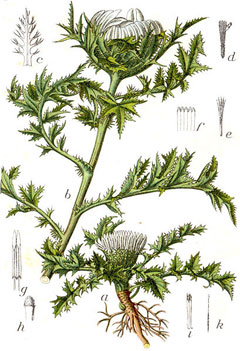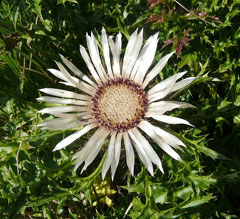 |
|
http://commons.wikimedia.org/wiki/File:Carlina_acaulis_Sturm17.jpg |
 |
| http://commons.wikimedia.org/wiki/User:BerndH |
Translate this page:
Summary
Physical Characteristics

 Carlina acaulis is a BIENNIAL/PERENNIAL growing to 0.2 m (0ft 8in) by 0.3 m (1ft).
Carlina acaulis is a BIENNIAL/PERENNIAL growing to 0.2 m (0ft 8in) by 0.3 m (1ft).
See above for USDA hardiness. It is hardy to UK zone 4. It is in flower in June, and the seeds ripen from July to August. The species is hermaphrodite (has both male and female organs) and is pollinated by Bees, Lepidoptera (Moths & Butterflies). The plant is self-fertile.
Suitable for: light (sandy), medium (loamy) and heavy (clay) soils, prefers well-drained soil and can grow in nutritionally poor soil. Suitable pH: mildly acid, neutral and basic (mildly alkaline) soils and can grow in very alkaline soils.
It cannot grow in the shade. It prefers dry or moist soil.
UK Hardiness Map
US Hardiness Map
Synonyms
Plant Habitats
Cultivated Beds;
Edible Uses
Edible Parts: Flowers Root Stem
Edible Uses:
Flowering head - cooked. Used as a globe artichoke substitute[177, 183], though they are considerably smaller and even more fiddly[K]. The fleshy centre of the plant is edible[7, 105]. Does this refer to the peeled stem?[K]. Root[13]. No more details are given.
References More on Edible Uses
Medicinal Uses
Plants For A Future can not take any responsibility for any adverse effects from the use of plants. Always seek advice from a professional before using a plant medicinally.
Antispasmodic Carminative Diaphoretic Digestive Diuretic Eczema Emetic Febrifuge
Purgative
Stemless carline thistle is seldom used in modern herbalism. The plant was at one time in great demand as an aphrodisiac[7], it is occasionally used nowadays in the treatment of spasms of the digestive tract, gall bladder and liver disorders, dropsy, urine retention etc[9, 268]. The root has also been used in treating a range of skin complaints such as acne and eczema[268]. A decoction of the root can be used externally to cleanse wounds or as an antiseptic gargle[268]. Some caution should be employed since in large doses the root is purgative and emetic[268]. The root is antibiotic, antispasmodic, carminative, diaphoretic, digestive, mildly diuretic, emetic in large doses, febrifuge and purgative in large doses[7, 9, 21, 46]. The root is harvested in the autumn and dried for later use[7].
References More on Medicinal Uses
The Bookshop: Edible Plant Books
Our Latest books on Perennial Plants For Food Forests and Permaculture Gardens in paperback or digital formats.

Edible Tropical Plants
Food Forest Plants for Hotter Conditions: 250+ Plants For Tropical Food Forests & Permaculture Gardens.
More

Edible Temperate Plants
Plants for Your Food Forest: 500 Plants for Temperate Food Forests & Permaculture Gardens.
More

More Books
PFAF have eight books available in paperback and digital formats. Browse the shop for more information.
Shop Now
Other Uses
Weather forecasting
The dried flowers respond to the amount of humidity in the air and can be used as hygrometers[100]. Flowers on the growing plant close at the approach of rain[268].
Special Uses
References More on Other Uses
Cultivation details
Succeeds in a sunny position in ordinary garden soil[111]. Prefers a neutral to alkaline soil[138, 238]. Prefers a poor soil[200]. Established plants are drought tolerant[190]. Plants are hardy to about -20°c[187]. The stemless carline thistle is a protected plant in the wild because of its rarity[7]. This species resents root disturbance, it should be planted into its final position as soon as possible[138]. Plants are usually short-lived or monocarpic[187]. The plant is popular in dried flower arranging, the dried heads keeping their appearance indefinitely[7].
References Carbon Farming Information and Carbon Sequestration Information
Temperature Converter
Type a value in the Celsius field to convert the value to Fahrenheit:
Fahrenheit:
The PFAF Bookshop
Plants For A Future have a number of books available in paperback and digital form. Book titles include Edible Plants, Edible Perennials, Edible Trees,Edible Shrubs, Woodland Gardening, and Temperate Food Forest Plants. Our new book is Food Forest Plants For Hotter Conditions (Tropical and Sub-Tropical).
Shop Now
Plant Propagation
Seed - surface sow in a cold frame in the spring. The seed usually germinates in 4 - 8 weeks at 15°c[138]. As soon as they are large enough to handle, prick the seedlings out into individual pots and plant them out into their permanent positions in the summer.
Other Names
If available other names are mentioned here
Native Range
EUROPE: Austria, Switzerland, Czech Republic, Germany, Hungary, Poland, Slovakia, Belarus, Moldova, Ukraine, Albania, Bulgaria, Bosnia and Herzegovina, Greece (incl. Crete), Croatia, Italy, North Macedonia, Montenegro, Romania, Serbia, Slovenia, Spain, France
Weed Potential
Right plant wrong place. We are currently updating this section.
Please note that a plant may be invasive in one area but may not in your area so it's worth checking.
Conservation Status
IUCN Red List of Threatened Plants Status :

Growth: S = slow M = medium F = fast. Soil: L = light (sandy) M = medium H = heavy (clay). pH: A = acid N = neutral B = basic (alkaline). Shade: F = full shade S = semi-shade N = no shade. Moisture: D = dry M = Moist We = wet Wa = water.
Now available:
Food Forest Plants for Mediterranean Conditions
350+ Perennial Plants For Mediterranean and Drier Food Forests and Permaculture Gardens.
[Paperback and eBook]
This is the third in Plants For A Future's series of plant guides for food forests tailored to
specific climate zones. Following volumes on temperate and tropical ecosystems, this book focuses
on species suited to Mediterranean conditions—regions with hot, dry summers and cool, wet winters,
often facing the added challenge of climate change.
Read More
Expert comment
Author
L.
Botanical References
100200
Links / References
For a list of references used on this page please go here
Readers comment
© 2010, Plants For A Future. Plants For A Future is a charitable company limited by guarantee, registered in England and Wales. Charity No. 1057719, Company No. 3204567.